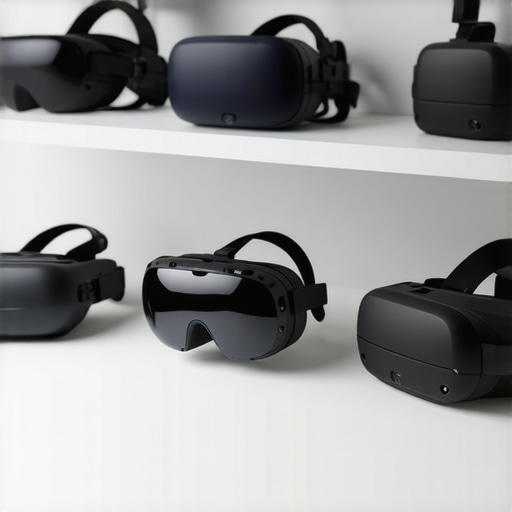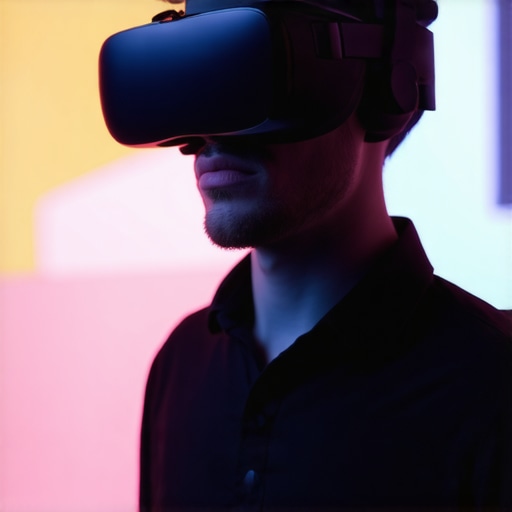My Journey Into the World of AR Headsets — A Personal Perspective
Ever since I first slipped on an augmented reality (AR) headset, I knew I was stepping into a new era of immersive technology. I remember unboxing my first device with a mix of curiosity and excitement, eager to explore how AR could transform gaming, work, and daily life. Over time, I’ve become quite the enthusiast, constantly researching and testing the latest models and accessories to stay ahead in this rapidly evolving landscape.
Why I Believe AR Headsets Are the Future of Virtual & Mixed Reality
From my experience, AR headsets offer a unique blend of real-world interaction and digital enhancement. Unlike traditional VR, which often isolates you completely, AR integrates seamlessly with your environment, making it more practical for everyday use. I’ve found that the best AR devices, like those highlighted in top AR headsets in 2025, are becoming more affordable and user-friendly, opening new possibilities for both consumers and professionals.
Discovering the Best AR Accessories to Boost My Experience
One thing I’ve learned is that accessories can make a significant difference. From ergonomic controllers to protective cases, each addition enhances comfort and functionality. For example, I recently upgraded my setup with some of the must-have XR accessories that truly transformed my virtual interactions. These tools not only improve immersion but also extend device lifespan and ease of use.
How Do I Choose the Right AR Headset? My Personal Tips
Deciding on the perfect AR headset can be overwhelming. I usually consider factors like display quality, comfort, battery life, and compatibility with my existing devices. Reading reviews from trusted sources, such as exploring top AR headsets, helped me make informed choices. Also, I always look out for bundles and deals, especially around major sales events, to get the best value for my investment.
What Are the Key Features to Look for in 2025’s Best AR Headsets?
In my view, the most important features include high-resolution displays, wide field of view, lightweight design, and seamless connectivity. Manufacturers are now focusing on making devices more comfortable for prolonged use, which I appreciate as someone who wears headsets for hours during work or gaming sessions. Staying updated with industry reports, like those from best VR deals for 2025, keeps me informed about the latest innovations and discounts.
If you’re passionate about AR or just starting to explore, I encourage you to share your experiences or ask questions below. Exploring this technology together makes the journey even more exciting!
What Are the Cutting-Edge Features Defining 2025’s Top AR Headsets?
As augmented reality technology continues its rapid evolution, 2025 promises to bring innovative features that will redefine user experience. High-resolution displays with 8K clarity, combined with ultra-wide fields of view surpassing 120 degrees, are now becoming standard. These improvements enable more immersive and natural interactions, blurring the line between virtual and real worlds. Additionally, lightweight ergonomic designs and adjustable fits are crucial for prolonged wear, making AR devices more comfortable for daily use. Connectivity options have also expanded, with seamless integration into cloud services and IoT ecosystems, allowing for real-time data sharing and collaborative experiences.
How Do Industry Leaders Innovate in a Competitive AR Market?
Leading manufacturers are investing heavily in research and development, focusing on miniaturization and energy efficiency. This effort results in sleek devices with longer battery life, often exceeding 10 hours of continuous use. Furthermore, advanced sensors and AI-driven features enhance spatial awareness and contextual understanding, making AR applications smarter and more intuitive. For example, some headsets now incorporate eye-tracking and hand gesture recognition, enabling more natural interaction without controllers. To stay ahead, companies are also forming strategic partnerships with software developers and content creators, ensuring a rich ecosystem of applications that appeal to both consumers and enterprises.
How Can Experts and Enthusiasts Leverage These Innovations for Practical Use?
Professionals can utilize the latest AR headsets for a variety of practical applications, from remote collaboration and training to 3D modeling and design. For instance, architects and engineers are now visualizing complex structures in real-time, enhancing accuracy and efficiency. Educators are creating immersive learning experiences that engage students more deeply. Meanwhile, gamers and hobbyists benefit from the improved fidelity and comfort, expanding the potential for entertainment and social interaction. For those interested in exploring the best deals and bundles, resources like this comprehensive guide offer valuable insights and discounts. Moreover, integrating accessories such as spatial audio devices and haptic feedback suits can elevate immersion to new levels. Curious about how these innovations can fit into your workflow or leisure activities? Share your thoughts or questions in the comments below and continue your journey into the future of augmented reality.
Embracing the Nuances of Mixed Reality: A Personal Reflection
As I delve further into the world of AR headsets, I realize that the journey is far more intricate than initial impressions might suggest. The technology’s rapid evolution has introduced layers of complexity—beyond high-resolution displays or ergonomic designs—that challenge even seasoned enthusiasts like myself. For example, the integration of AI-driven spatial understanding in headsets, such as those discussed in this comprehensive guide, exemplifies how immersive experiences are becoming smarter and more contextual. These advancements require not just hardware upgrades but also a shift in how we perceive and utilize AR in everyday life.
How Do Personal Experiences Shape Our Expectations for AR in 2025?
In my own exploration, I’ve found that expectations often clash with real-world capabilities. When I first tried the latest AR headsets, I was captivated by their potential but also aware of their limitations—like battery longevity or field of view constraints. As I read industry reports and user reviews, I understood that the true value lies in how these devices seamlessly integrate into our routines. For instance, I’ve started using AR for remote collaboration, which has transformed my workflow, making it more interactive and intuitive. It’s this kind of personal evolution—adapting to new tech—that shapes my perspective on what AR can realistically achieve in 2025 and beyond.
Imagine a sleek AR headset with a panoramic, ultra-high-definition display, comfortably worn during a professional meeting, seamlessly blending virtual data with real-world surroundings. This image encapsulates my ongoing journey and the future I envision for immersive technology.
What Are the Ethical and Practical Considerations of Advanced AR?
While the technological marvels excite me, I’m also mindful of the ethical and practical questions they raise. Privacy concerns, data security, and the potential for digital distraction are issues that I believe we must address collectively. For example, as AR devices become more integrated with cloud ecosystems—highlighted in the privacy policy—ensuring user data protection is paramount. Personally, I’m advocating for responsible use and transparent policies, which are vital for fostering trust and widespread adoption.
How Can Enthusiasts Like Me Contribute to the Future of AR?
Engagement and feedback are crucial. Sharing experiences, participating in beta testing, and advocating for user-centric design help shape the technology’s trajectory. I regularly contribute to online forums and review sites, encouraging developers to prioritize comfort and usability. If you’re curious about how to deepen your involvement, I recommend exploring the latest top AR headsets and sharing your insights. Together, our voices can influence the development of smarter, more ethical, and more accessible AR solutions.
Unlocking the Depths of Spatial Awareness and AI Integration in AR
As my journey into the intricacies of augmented reality progresses, I’ve come to appreciate how the fusion of advanced sensors and artificial intelligence is revolutionizing user experiences. The latest AR headsets, such as those discussed in top AR headsets in 2025, are equipped with multi-sensor arrays that enable precise spatial mapping, real-time environmental understanding, and contextual responsiveness. These developments transcend simple overlay functionalities, creating immersive environments that adapt dynamically to user intent and surroundings. For example, AI-driven spatial understanding allows for more natural interactions, like gesture-based commands that mimic real-world behavior, significantly reducing the learning curve for new users.
The Challenge of Balancing High-Resolution Displays with Ergonomic Design
While high-resolution displays—sometimes exceeding 8K clarity—are critical for realism, they pose ergonomic challenges. The weight and heat generated by such displays can compromise comfort during extended use. To address this, manufacturers are exploring innovative materials and cooling technologies, as well as modular designs that distribute weight more evenly. This focus on ergonomic refinement is essential, especially as professionals leverage AR for prolonged periods, including complex tasks like 3D modeling or remote surgical assistance. The evolution of lightweight yet powerful headsets is a testament to the industry’s commitment to user-centric design, as highlighted in exploring top AR headsets.
How Are Ethical Dilemmas Shaping the Future of AR Development?
Beyond hardware advancements, the ethical landscape surrounding AR technology is becoming increasingly complex. Privacy concerns, data security, and the potential for digital distraction demand rigorous standards and transparent policies. As I delve into the privacy policies outlined in the privacy policy, I recognize that safeguarding user data—especially when devices are integrated into cloud ecosystems—is paramount. Ethical development also involves considering the social implications of AR, such as digital addiction or the blurring of virtual and real-world boundaries. Industry leaders are now advocating for responsible use frameworks and user education, fostering trust and encouraging widespread adoption of these transformative tools.
Can Personal Experiences Inform the Ethical Evolution of AR?
Absolutely. My personal encounters with AR have shown me that user behavior and feedback are vital in shaping ethical standards. For instance, my awareness of digital distraction led me to advocate for user-configurable notifications and focus modes, which enhance productivity without sacrificing engagement. Contributing to online forums and beta testing initiatives allows enthusiasts like myself to influence developers toward more ethical design choices. If you’re interested in how these insights can inform responsible innovation, I encourage you to explore mix reality bundles for 2025 and share your experiences or concerns—your voice can drive meaningful change in this rapidly evolving field.
What is the Role of Mixed Reality in Shaping a Digital-Physical Hybrid Future?
Mixed reality (MR) stands at the forefront of bridging virtual and physical worlds, offering a seamless continuum that enhances our daily interactions. Thanks to innovations in spatial computing and AI, MR devices now facilitate real-time collaboration with digital objects integrated into our physical environment. This capability is transforming industries—from manufacturing and healthcare to education—making processes more intuitive and efficient. For example, the integration of MR in training simulations allows learners to interact with lifelike scenarios without physical risks, exemplifying the profound potential of this technology. As I explore the latest in best VR bundles for 2025, I see a future where the boundaries between digital and physical are increasingly blurred, fostering a new era of hybrid experiences.
How Can Enthusiasts Contribute to Ethical and Technological Progress?
Engaged users and industry insiders alike have a responsibility to advocate for ethical standards and technological excellence. Participating in beta testing, providing constructive feedback, and staying informed about industry developments—such as those outlined in breaking VR deals—are vital for shaping a responsible ecosystem. Additionally, sharing insights through blogs and forums encourages transparency and drives innovation aligned with user needs. If you’re eager to deepen your involvement, I invite you to explore VR deal guides and consider how your experiences can influence future developments. Our collective voices are essential in steering AR toward an ethical and inclusive future, where technology truly serves humanity’s best interests.
Things I Wish I Knew Earlier (or You Might Find Surprising)
1. The Hidden Depths of AR Hardware
When I first started exploring AR headsets, I underestimated how much the hardware intricacies—like sensor placement and ergonomic design—could impact overall experience. Discovering that lightweight materials and balanced weight distribution make hours of use comfortable was a game-changer for me. It’s not just about high-tech features but also about how the device feels on your head.
2. The Power of Accessories in Enhancing Immersion
Initially, I thought the headset alone was enough. However, adding accessories such as spatial audio devices or haptic feedback suits truly transformed my interactions, making experiences more realistic and engaging. These little upgrades can significantly boost productivity and enjoyment.
3. Ethical Considerations Are Closer Than They Appear
I didn’t realize early on how important privacy policies and data security are when adopting AR technology. As these devices become more integrated with cloud services, understanding and advocating for responsible data use became essential for me to trust and enjoy the tech fully.
4. The Role of AI in Making AR Smarter
Seeing how AI-driven spatial understanding and gesture recognition are evolving opened my eyes to the potential of smarter AR experiences. It’s fascinating how these advancements make interactions more natural, almost like talking to a helpful companion rather than just using a device.
5. The Limitations Still Present
Despite all the exciting developments, I’ve learned to manage expectations. Battery life, field of view, and comfort still have room for improvement. Patience and keeping up with industry updates help me stay realistic and appreciate the rapid progress.
6. Personal Use Shapes the Future
My own experiences have shown me that user feedback is vital. Participating in beta programs and sharing honest reviews can influence future innovations, making AR more aligned with real needs and ethical standards.
Resources I’ve Come to Trust Over Time
- RealityPlay Deals: This site offers comprehensive reviews and latest deals, which have helped me find the best value AR headsets and accessories. It’s my go-to source for staying updated.
- ARVR Magazine: An authoritative industry publication that provides in-depth analysis and forecasts, helping me understand technological trends and ethical considerations.
- Official Manufacturer Websites: Direct sources like Oculus or HTC offer detailed specs and privacy policies, essential for making informed choices.
- Tech Review Channels: YouTube reviewers I trust provide honest insights into real-world usage, which is invaluable when deciding on purchases.
Parting Thoughts from My Perspective
Exploring the evolving landscape of augmented reality in 2025 has been a rewarding journey, filled with discoveries and lessons. The key takeaway is that while technology continues to advance rapidly, understanding its ethical implications and how it fits into our personal and professional lives is equally important. I believe that by staying informed, sharing our experiences, and advocating for responsible use, we can help shape a future where AR truly benefits everyone. If this resonated with you, I’d love to hear your thoughts or experiences. Share it with someone who might find it helpful, and let’s continue this exciting journey into the future of AR together.


